lights PONTIAC BONNEVILLE 1994 Owners Manual
[x] Cancel search | Manufacturer: PONTIAC, Model Year: 1994, Model line: BONNEVILLE, Model: PONTIAC BONNEVILLE 1994Pages: 290, PDF Size: 14.75 MB
Page 6 of 290
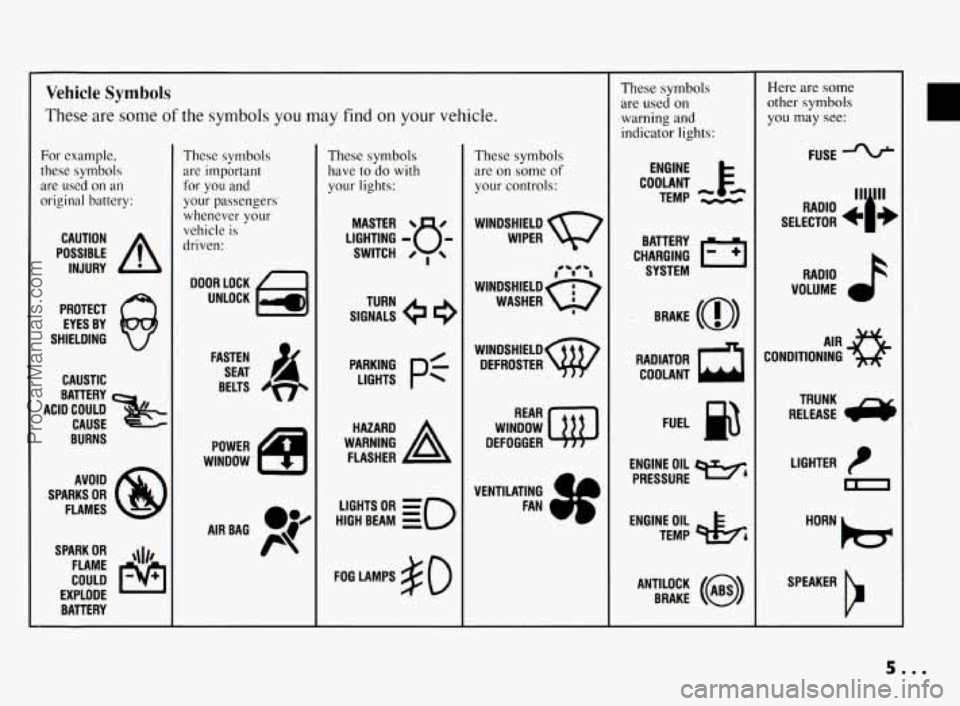
Vehicle Symbols
These are some of the symbols you may find on your vehicle.
For example,
these symbols
are used on an
original battery:
POSSIBLE A
CAUTION
INJURY
PROTECT EYES BY
SHIELDING
CAUSTIC
ACID COULD BATTERY
CAUSE
BURNS
AVOID
SPARKS
OR
FLAMES
SPARK
OR ,111,
COULD FLAME
EXPLODE BATTERY
These symbols
are important
for you and
your passengers
whenever your
vehicle
is
driven:
DOOR LOCK
UNLOCK
FASTEN SEAT
4
BELTS
POWER
WINDOW
'* -- I
These symbols
have to do with
your lights:
SIGNALS e
TURN
HIGH BEAM
OR = =o
FOG LAMPS $0
These symbols
are
on some of
your controls:
WIPER Q7
WINDSHIELD
DEFROSTER
WINDOW
DEFOGGER
VENTILATING
4
FAN (I
These symbols
are used
on
warning and
indicator lights:
COOLANT Fa
TEMP --
ENGINE
CHARGING
I-1
BATTERY SYSTEM
BRAKE
(0)
RADIATOR COOLANT
FUEL
ENGINE OIL
PRESSURE
Wb
TEMP OIL ?b
ANTILOCK (@)
BRAKE
Here are some
other symbols
you may see:
FUSE
11lp RADIO , - -
SELECTOR b I JE
RADIO
VOLUME
CONDITIONING
AIR 43
LIGHTER
m
SPEAKER
b
5.00
ProCarManuals.com
Page 12 of 290
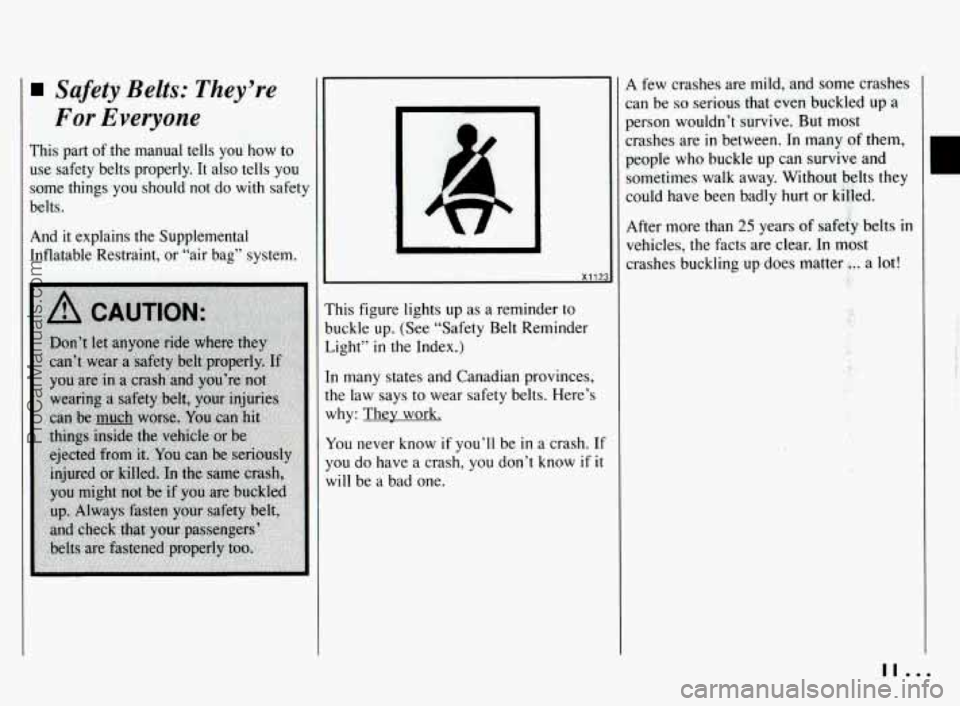
Safety Belts: They’re
For Everyone
This part of the manual tells you how to
use safety belts properly. It also tells you
some things you should not do with safety
belts
.
And it explains the Supplemental
Inflatable Restraint, or “air bag” system.
This figure lights up as a reminder to
buckle
up. (See “Safety Belt Reminder
Light”
in the Index.)
In many states and Canadian provinces,
the law says to wear safety belts. Here’s
why: They work.
You never know if you’ll be in a crash. If
you do have a crash, you don’t know
if it
will be a bad one.
A few crashes are mild, and some crashes
:an be
so serious that even buckled up a
person wouldn’t survive.
But most
:rashes are
in between. In many of them,
people who buckle up can survive and
sometimes walk away. Without belts they
could have been badly hurt or killed.
After more than
25 years of safeiy belts in
vehicles, the facts are clear. In most
crashes buckling up does matter
4.. a lot!
.:5 ”
,? , ‘i I
,
r
II ...
ProCarManuals.com
Page 46 of 290
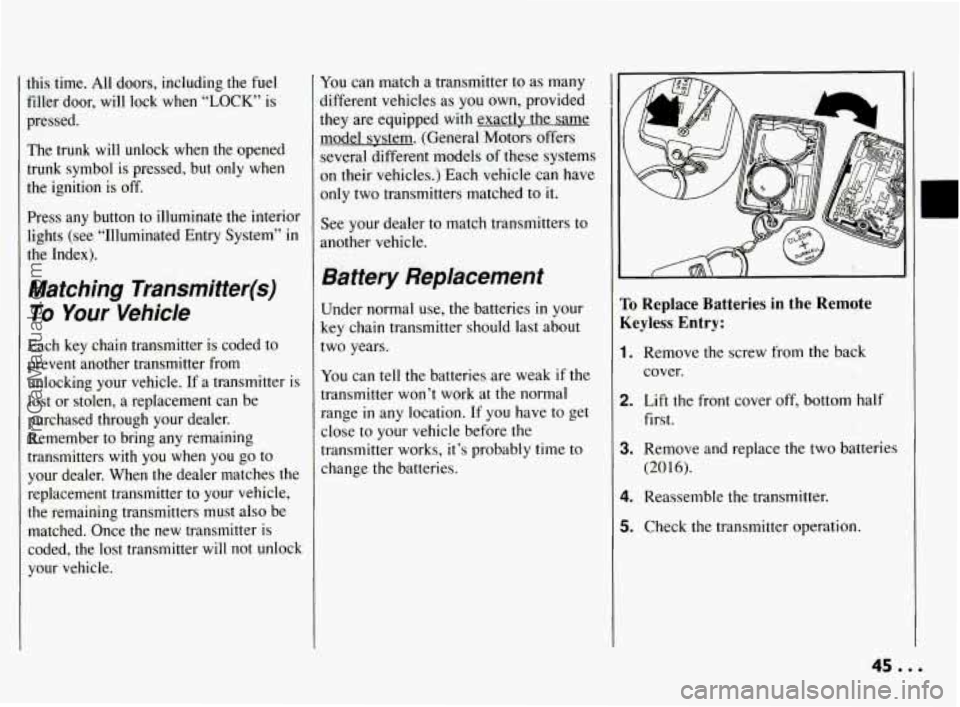
this time. All doors, including the fuel
filler door,
will lock when “LOCK” is
pressed.
The trunk
will unlock when the opened
trunk symbol is pressed, but only when
the ignition is off.
Press any button to illuminate the interior
lights (see “Illuminated Entry System’’
in
the Index).
Matching Transmitter(s)
To Your Vehicle
Each key chain transmitter is coded to
prevent another transmitter from
unlocking your vehicle. If a transmitter is
lost or stolen,
a replacement can be
purchased through your dealer.
Remember
to bring any remaining
transmitters
with you when you go to
your dealer. When the dealer matches the
replacement transmitter to your vehicle,
the remaining transmitters
must also be
matched. Once the new transmitter is
coded, the lost transmitter
will not unlock
your vehicle.
You can match a transmitter to as many
different vehicles as
you own, provided
they are equipped with exactlv the same
model system. (General Motors offers
several different models of these systems
on their vehicles.) Each vehicle can have
only two transmitters matched to it.
See your dealer to match transmitters to
another vehicle.
Battery Replacement
Under normal use, the batteries in your
key chain transmitter should last about
two years.
You can tell the batteries are weak if the
transmitter won’t work at the normal
range
in any location. If you have to get
close to your vehicle before the
transmitter works, it’s probably time
to
change the batteries.
ro Replace Batteries in the Remote
Keyless Entry:
I. Remove the screw from the back
cover.
2. Lift the front cover off, bottom half
first.
3. Remove and replace the two batteries
(2016).
4. Reassemble the transmitter.
i. Check the transmitter operation.
45e.o
ProCarManuals.com
Page 50 of 290
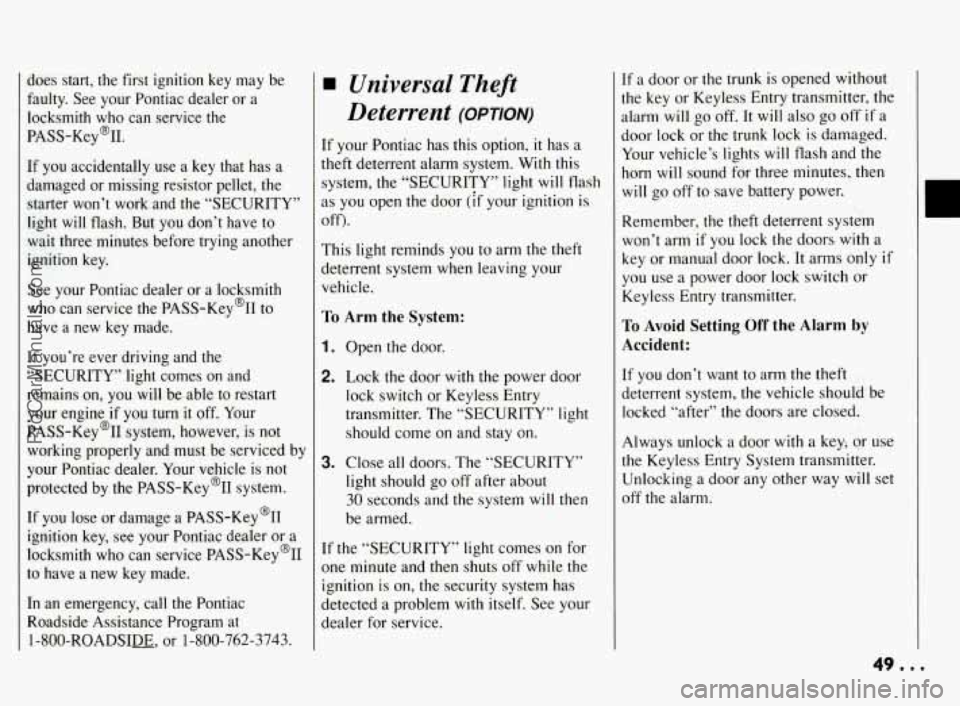
does start, the first ignition key may be
faulty. See your Pontiac dealer or a
locksmith who can service the
PASS-Key’II.
If you accidentally use
a key that has a
damaged
or missing resistor pellet, the
starter won’t work and the “SECURITY”
light
will flash. But you don’t have to
wait three minutes before trying another
ignition key.
See your Pontiac dealer or a locksmith
who can service the PASS-Key@II to
have
a new key made.
If you’re ever driving and the
“SECURITY” light comes on and
remains on, you
will be able to restart
your engine
if you turn it off. Your
PASS-Key@II system, however, is not working properly and must be serviced by
your Pontiac dealer. Your vehicle is not
protected by the PASS-Key@II system.
If you lose or damage
a PASS-Key@II
ignition key, see your Pontiac dealer or a
locksmith who can service PASS-Key@II
to have a new key made.
In an emergency, call the Pontiac
Roadside Assistance Program at
1-800-ROADSIDE, or
1-800-762-3743.
Universal Theft
Deterrent
-(OPTION)
If your Pontiac has this option, it has a
theft deterrent alarm system. With this
system, the “SECURITY”
light will flash
as you open the door
(if your ignition is
off).
This light reminds you to arm
the theft
deterrent system when leaving your
vehicle.
To Arm the System:
1. Open the door.
2. Lock the door with the power door
lock switch or Keyless Entry
transmitter. The “SECURITY” light
should come on and stay on.
3. Close all doors. The “SECURITY”
light should go off after about
30 seconds and the system will then
be armed.
If the “SECURITY” light comes on for
one
minute and then shuts off while the
ignition is on, the security system has
detected a problem with itself. See your
dealer for service.
If a door or the trunk is opened without
the key or Keyless Entry transmitter, the
alarm
will go off. It will also go off if a
door lock or the trunk lock is damaged.
Your vehicle’s lights
will flash and the
horn
will sound for three minutes, then
will go off to save battery power.
Remember, the theft deterrent system
won’t arm
if you lock the doors with a
key or manual door lock. It arms only if
you use a power door lock switch or
Keyless Entry transmitter.
To Avoid Setting Off the Alarm by
Accident:
If you don’t want to arm the theft
deterrent system, the vehicle should be
locked “after”
the doors are closed.
Always unlock
a door with a ke,y; or use
the Keyless Entry System transmitter.
Unlocking a door any other way will set
off the alarm.
ProCarManuals.com
Page 51 of 290
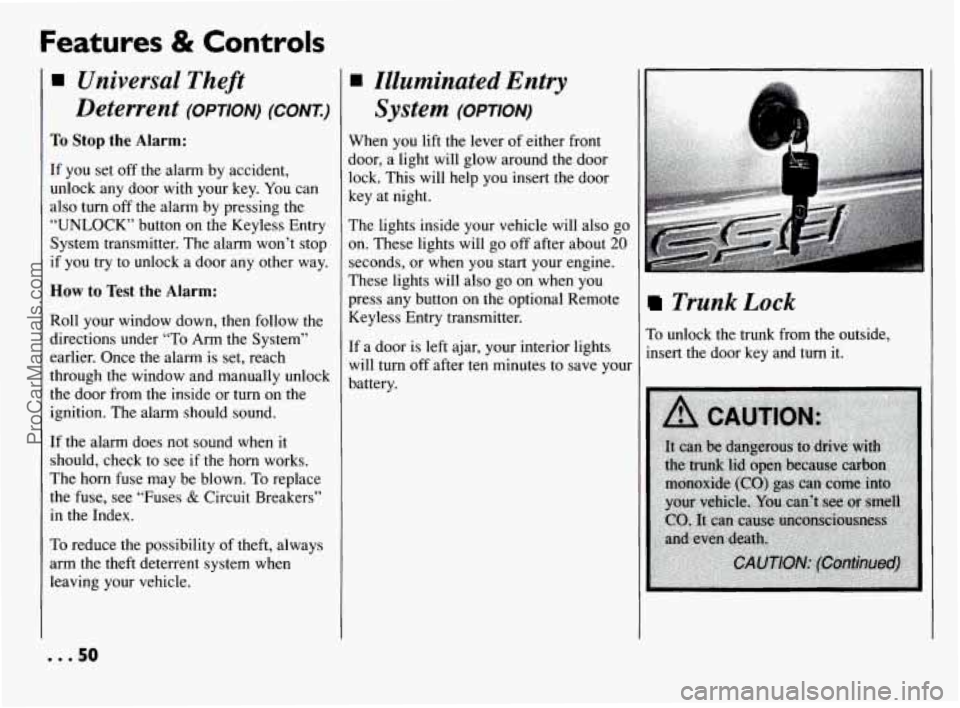
Features & Controls
Universal Theft
Deterrent
(omoN) (CONI)
To Stop the Alarm:
If you set off the alarm by accident,
unlock any door with your key.
You can
also
turn off the alarm by pressing the
“UNLOCK” button on the Keyless Entry
System transmitter. The alarm won’t stop
if you try to unlock a door any other way.
How to Test the Alarm:
Roll your window down, then follow the
directions under
“To Arm the System”
earlier. Once the alarm is set, reach
through the window and manually unlock
the door from the inside or
turn on the
ignition. The alarm should sound.
If the alarm does not sound when it
should, check to see
if the horn works.
The horn fuse may be blown. To replace
the fuse, see “Fuses
& Circuit Breakers”
in the Index.
To reduce the possibility
of theft, always
arm the theft deterrent system
when
leaving your vehicle.
H Illuminated Entry
System
(omoN)
When you lift the lever of either front
door, a light will glow around the door
lock. This will help you insert the door
key at night.
The lights inside your vehicle will also
go
on. These lights will go off after about 20
seconds, or when you start your engine.
These lights will also
go on when you
press any button on the optional Remote
Keyless Entry transmitter.
If a door is left ajar, your interior lights
will turn
off after ten minutes to save your
battery.
Trunk Lock
To unlock the trunk from the outside, insert the door key and
turn it.
... 50
ProCarManuals.com
Page 54 of 290
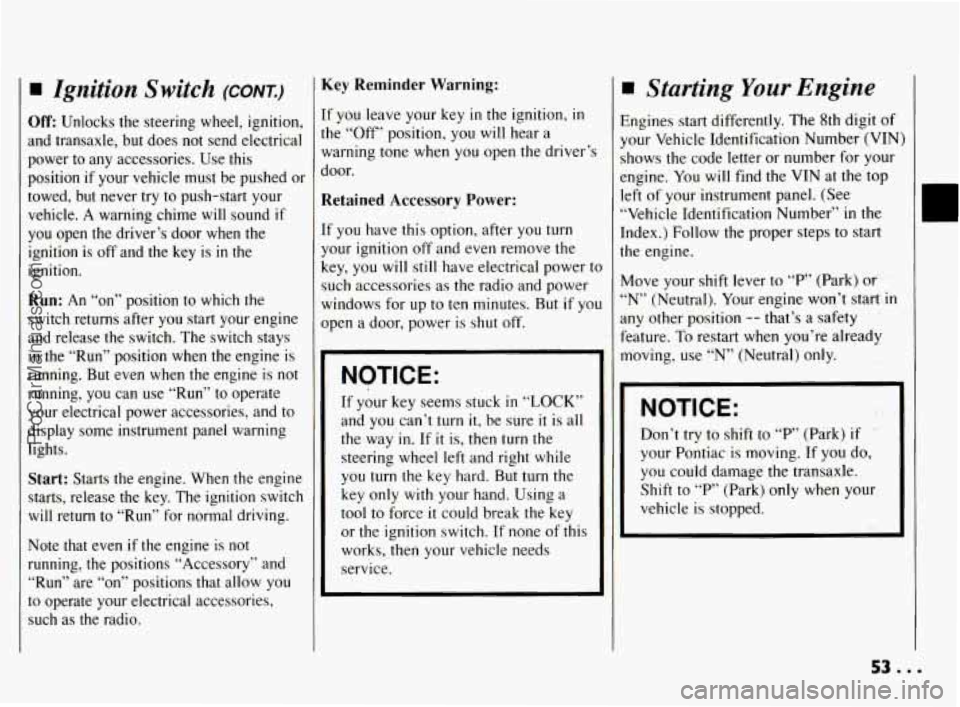
Ignition Switch (CONK)
Off: Unlocks the steering wheel, ignition,
and transaxle, but does not send electrical
power to any accessories. Use this
position
if your vehicle must be pushed or
towed,
but never try to push-start your
vehicle.
A warning chime will sound if
you open the driver’s door when the
ignition is off and the key is
in the
ignition.
Run: An “on” position to which the
switch returns after you start your engine
and release the switch. The switch stays
in the “Run” position when the engine is
running. But even when the engine is not
running, you can use “Run” to operate
your electrical power accessories, and to
display some instrument panel warning
lights.
Start: Starts the engine. When the engine
starts, release the key. The ignition switch
will return to “Run” for normal driving.
Note
that even if the engine is not
running, the positions “Accessory” and
“Run” are “on” positions that allow you
to operate your electrical accessories,
such as the radio.
Key Reminder Warning:
If you leave your key in the ignition, in
the “Off’ position, you will hear a
warning tone when you open the driver’s
door.
Retained Accessory Power:
If you have this option, after you turn
your ignition
off and even remove the
key, you
will still have electrical power to
such accessories as the radio and power
windows for
up to ten minutes. But if you
open
a door, power is shut off.
NOTICE:
If your key seems stuck in “LOCK”
and you can’t turn it, be sure it is all
the way
in. If it is, then turn the
steering wheel left and right
while
you turn the key hard. But turn the
key only
with your hand. Using a
tool to force it could break the key
or the ignition switch. If none
of this
works,
then your vehicle needs
service.
Starting Your Engine
Engines start differently. The 8th digit of
your Vehicle Identification Number (VIN)
shows the code letter or number for your
engine. You
will find the VIN at the top
left of your instrument panel. (See
“Vehicle Identification Number”
in the
Index.) Follow the proper steps to start
the engine.
Move your shift lever to
“P’ (Park) or
“N” (Neutral). Your engine won’t start in
any other position -- that’s a safety
feature. To restart when you’re already
loving, use
“N” (Neutral) only.
NOTICE:
Don’t try to shift to “P” (Park) if
your Pontiac is moving. If you do,
you could damage the transaxle.
Shift to
“P” (Park) only when your
vehicle is stopped.
ProCarManuals.com
Page 72 of 290
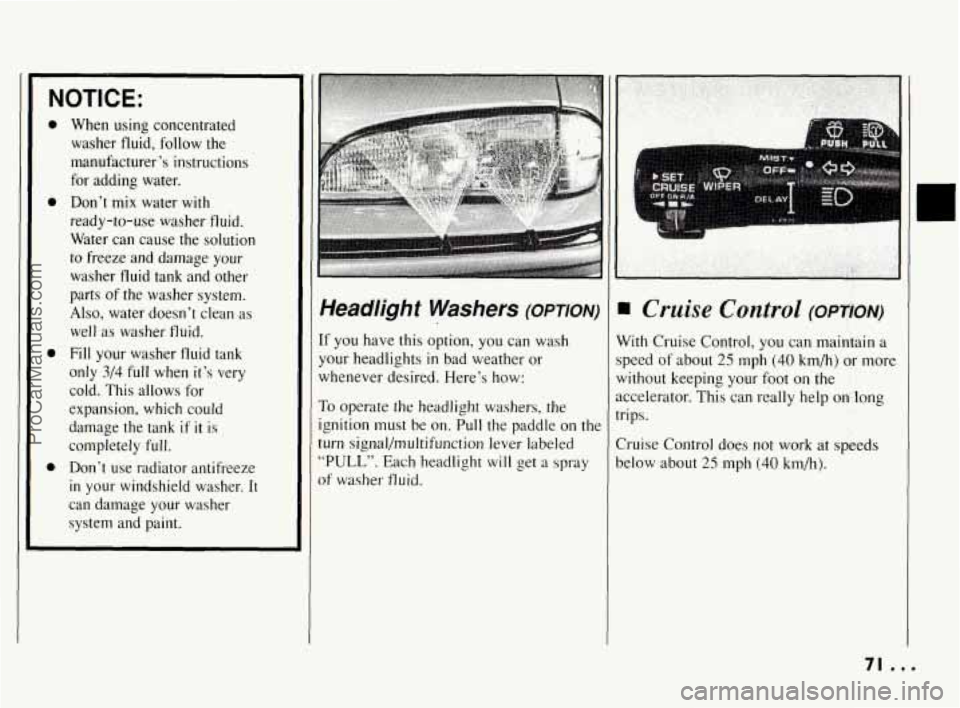
NOTICE:
0
a
When using concentrated
washer fluid, follow the
manufacturer’s instructions
for adding water.
Don’t mix water with
ready-to-use washer fluid.
Water can cause the solution
to freeze and damage your
washer fluid tank and other
parts
of the washer system.
Also, water doesn’t clean as
well as washer fluid.
Fill your washer fluid tank
only
314 full when it’s very
cold. This allows for
expansion, which could
damage the tank
if it is
completely
full.
Don’t use radiator antifreeze
in your windshield washer. It
can damage your washer
system and paint.
Headlight Washers (OPTION)
If you have this option, you can wash
your headlights
in bad weather or
whenever desired. Here’s how:
To operate the headlight washers, the
ignition must be
on. Pull the paddle on the
turn signal/multifunction lever labeled
“PULL”. Each headlight will get a spray
of washer fluid.
I
Cruise Control (opnoN)
With Cruise Control, you can maintain a
speed of about
25 mph (40 km/h) or more
without keeping
your foot on the
accelerator. This can really help
on long
trips.
Cruise Control does
not work at speeds
below about
25 mph (40 km/h).
71 ...
ProCarManuals.com
Page 75 of 290
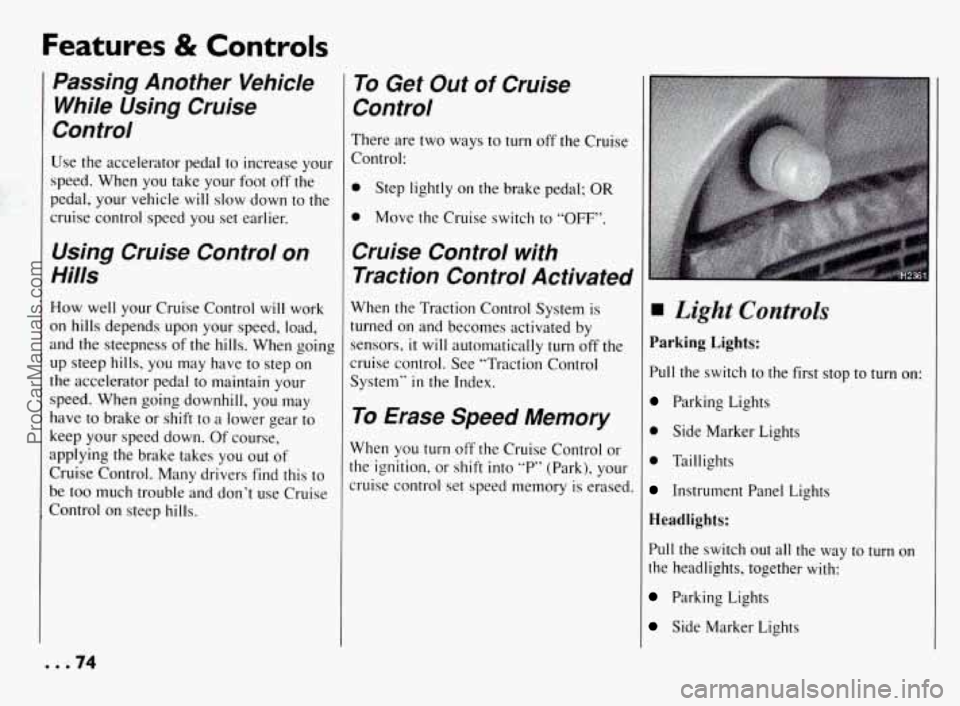
Features & Controls
Passing Another Vehicle While Using Cruise
Control
Use the accelerator pedal to increase your
speed. When you take your foot off the
pedal, your vehicle will
slow down to the
cruise control speed
you set earlier.
Using Cruise Control on
Hills
How well your Cruise Control will work
on hills depends upon your speed, load,
and the steepness of the hills. When going
up steep hills, you may have to step on
the accelerator pedal to maintain your
speed. When going downhill, you may
have to brake or shift to a lower gear to
keep
your speed down. Of course,
applying the brake takes you out
of
Cruise Control. Many drivers find this to
be too much trouble and don't use Cruise
Control on steep hills.
To Get Out of Cruise
Control
There are two ways to turn off the Cruise
Control:
0 Step lightly on the brake pedal; OR
0 Move the Cruise switch to "OFF".
Cruise Control with
Traction Control Activated
When the Traction Control System is
turned on and becomes activated by
sensors,
it will automatically turn off the
cruise control. See "Traction Control
System"
in the Index.
To Erase Speed Memory
When you turn off the Cruise Control or
the ignition, or shift into "P7 (Park), your
cruise control set speed memory is erased.
Light Controls
Parking Lights:
Pull the switch to the first stop to turn on:
Parking Lights
0 Side Marker Lights
0 Taillights
Instrument Panel Lights
Headlights:
Pull the switch out all the way to turn on
the headlights, together with:
Parking Lights
Side Marker Lights
ProCarManuals.com
Page 76 of 290
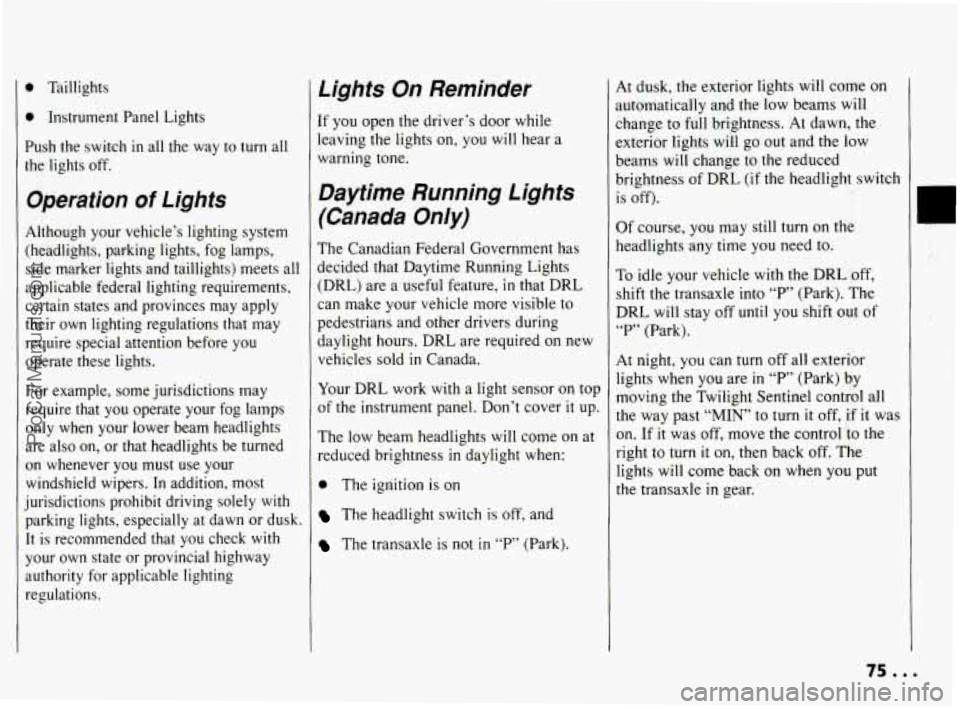
0 Taillights
0 Instrument Panel Lights
Push the switch
in all the way to turn all
the lights off.
Operation of Lights
Although your vehicle’s lighting system
(headlights, parking lights, fog lamps,
side marker lights and taillights) meets all
applicable federal lighting requirements,
certain states and provinces may apply
their own lighting regulations that may
require special attention before you
operate these lights.
For example, some jurisdictions may
require that you operate your fog lamps
only when your lower beam headlights
are also on, or that headlights be turned
on whenever you must use your
windshield wipers. In addition, most
jurisdictions prohibit driving solely
with
parking lights, especially at dawn or dusk.
It is recommended that you check with
your own state or provincial highway
authority for applicable lighting
regulations.
Lights On Reminder
[f you open the driver’s door while
leaving the lights on, you will hear a
warning tone.
Daytime Running Lights
(Canada Only)
The Canadian Federal Government has
decided that Daytime Running Lights
(DRL) are a useful feature,
in that DRL
can make your vehicle more visible to
pedestrians and other drivers during
daylight hours. DRL are required on new
vehicles sold
in Canada.
Your DRL work with a light sensor on top
of the instrument panel. Don’t cover it up.
The low beam headlights will come on at
reduced brightness
in daylight when:
0 The igdition is on
The headlight switch is off, and
The transaxle is not in “P” (Park).
4t dusk, the exterior lights will come on
mtornatically and the low beams will
:hange to full brightness. At dawn, the
:xterior lights will go out and the low
beams will change to the reduced
brightness of DRL (if the headlight switch
is off).
Of course, you may still turn on the
headlights any time you need to.
To idle your vehicle with the DRL ,off,
shift the transaxle into “P’ (Park). The
DRL will stay off until you shift out of
“P” (Park).
At night, you can turn off all exterior
lights when you are
in “P” (Park) by
moving the Twilight Sentinel control all
[he way past
“MIN” to turn it off, if it was
m. If it was off, move the control to the
right to turn it on, then back off. The
lights will come back on when you put
the transaxle
in gear.
75.0.
ProCarManuals.com
Page 77 of 290
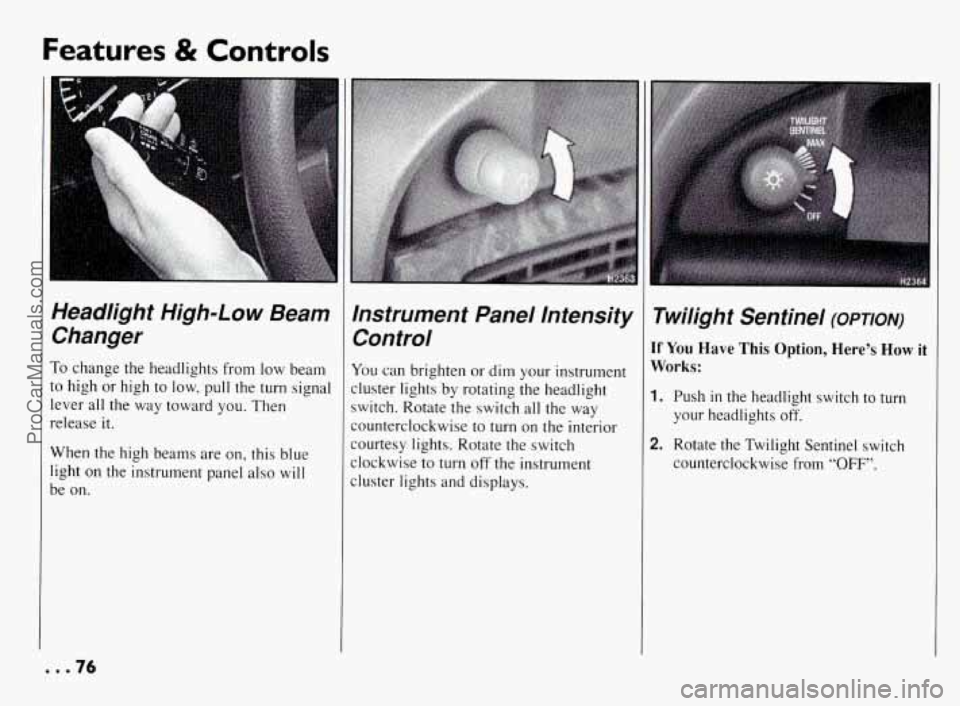
Features & Controls
Headlight High-Low Beam Changer
To change the headlights from low beam
to high or high
to low, pull the turn signal
lever all the way toward you. Then
release it.
When the high beams are on, this blue
light on the instrument panel
also will
be on.
Instrument Panel Intensity Control
You can brighten or dim your instrument
cluster lights by rotating the headlight
switch. Rotate the switch all the way
counterclockwise
to turn on the interior
courtesy lights. Rotate the switch
clockwise
to turn off the instrument
cluster lights and displays.
Twilight Sentinel (OPTION)
If You Have This Option, Here’s How it
Works:
1. Push in the headlight switch to turn
your headlights off.
2. Rotate the Twilight Sentinel switch
counterclockwise from
“OFF”.
... 76
ProCarManuals.com